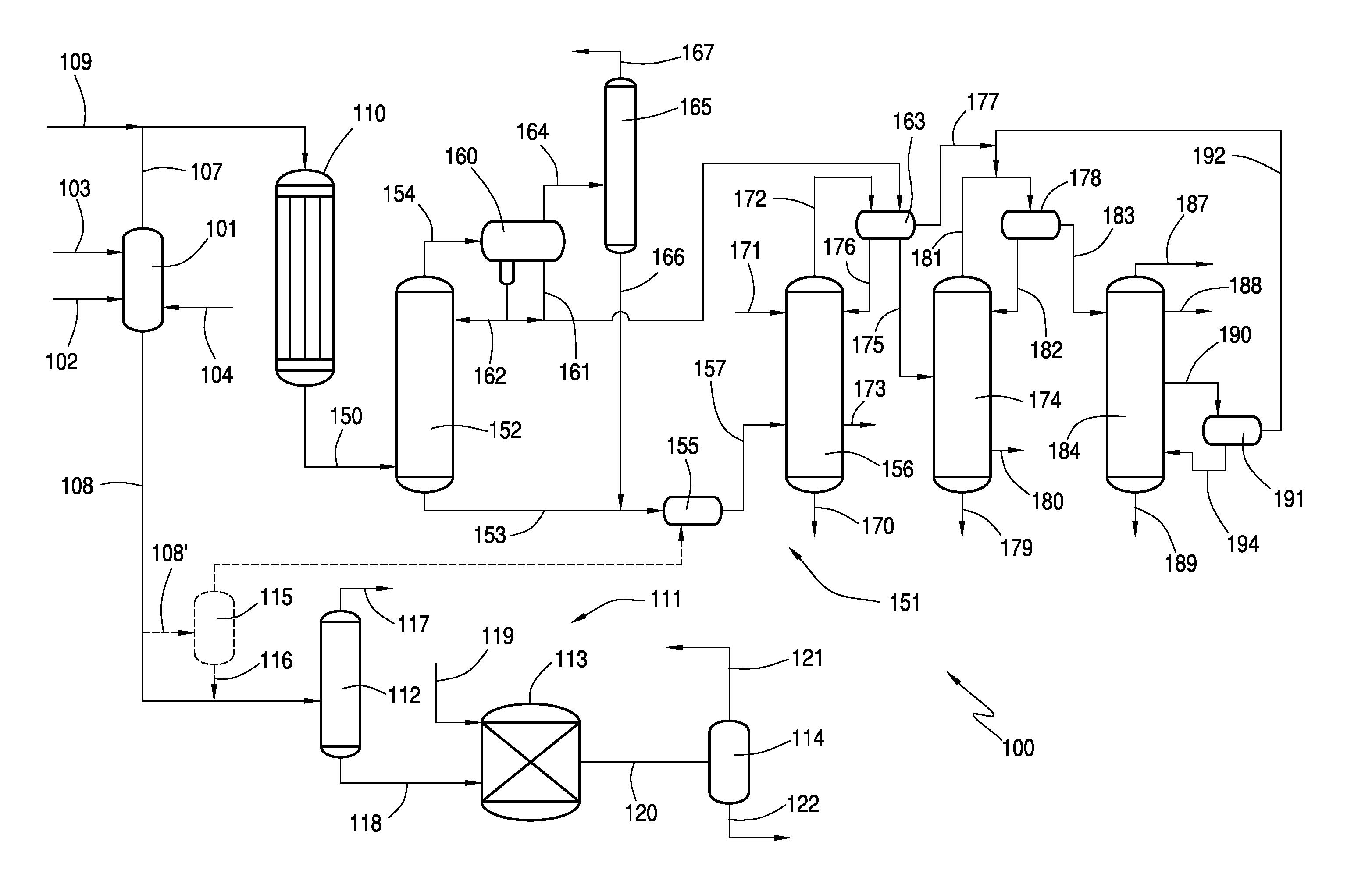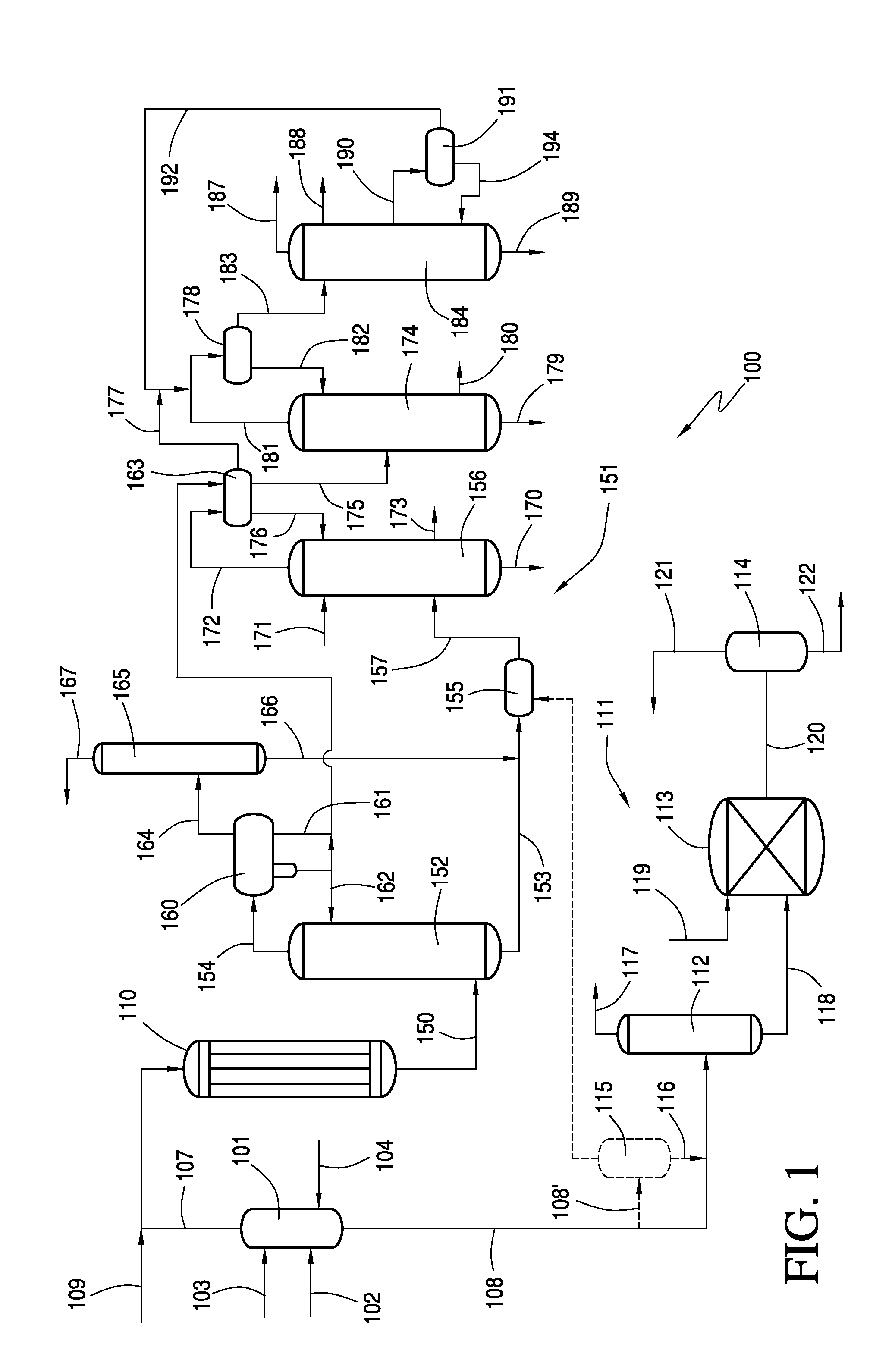Recovery of Acetic Acid from Heavy Ends in Vinyl Acetate Synthesis Process
a technology of acetic acid and vinyl acetate, which is applied in the preparation of carboxylic acid esters/lactones, organic chemistry, carboxylic compound preparations, etc., can solve the problems of reducing the yield of vinyl acetate, fouling of vinyl acetate production equipment, and affecting the formation of these heavy ends in many respects
- Summary
- Abstract
- Description
- Claims
- Application Information
AI Technical Summary
Benefits of technology
Problems solved by technology
Method used
Image
Examples
example 1
[0070]A heavy ends stream from a vinyl acetate production process was withdrawn from a heavy ends column. Heavy ends stream comprised 17.5 wt. % acetic acid, 41.9 wt. % acetate containing monomers and 37.8 wt. % acetate containing polymers. Heavy ends stream also comprises acetaldehyde and ethylene glycol. In terms of acetate containing monomers there was AAA (28.4 wt. %), ETDA (1.5 wt. %), EGMA (0.3 wt. %), VAA (1.1 wt. %), EDGA (7.9 wt. %), c-DAE (1.3 wt. %) and t-DAE (1.4 wt. %).
example 2
[0071]The heavy ends stream from Example 1 is fed to a hydrolysis reactor, as Run A. In addition, Run B, containing 45.2 wt. % acetate containing monomers and Run C, containing 38.8 wt. % acetate containing monomers were also fed to a hydrolysis reactor. The residence time of the hydrolysis reactor was 1.9 hours. The hydrolysis reaction was conducted in the absence of a catalyst. The heavy ends to water weight ratio for Runs A and B was 3.9:1 and for Run C is 3.8:1. The temperature of the reactor varied as indicated in Table 2. Table 2 also provides a summary of the results.
[0072]In Tables 2, 3, and 4, % accountability refers to the percentage of carbon accounted for in the hydrolyzed stream from the heavy ends stream after hydrolysis. % additional HOAc refers to the HOAc produced from the hydrolysis reactor that is in addition to any HOAc in the heavy ends stream. Reaction efficiency refers to percentage of theoretical acetic acid in heavy ends stream over the actual amount of acet...
example 3
[0074]Heavy ends streams from a vinyl acetate production process were fed to a hydrolysis reactor. Runs D and E are analyzed along with Run A from Example 1. Run D contained 39.7 wt. % acetate containing monomers and Run E contained 46.2 wt. % acetate containing monomers. The hydrolysis reaction was conducted in the absence of a catalyst. The residence times for each run was varied, as indicated in Table 3. Table 3 also provides a summary of the results.
TABLE 3Run DRun ARun EResidence Time1.5 hours1.9 hours2.3 hoursHE:H2O Ratio3.8:13.8:14.1:1Temperature144.7° C.145.6° C.144.2° C.% accountability97.0% 96.7% 96.7% % additional HOAc122.6% 115.6% 87.4% Reaction Efficiency77.9% 80.9% 61.1% Viscosity34.0 cps42.4 cps36.7 cps% ConversionsETDA38%41%47%VAA97%97%98%EGMA63%63%68%c-DAE94%95%96%t-DAE95%96%97%AAA73%75%79%
[0075]At lower residence times, Runs D and A more than doubled the amount of acetic acid recovered. In addition, at higher residence times there was a slight improvement ...
PUM
| Property | Measurement | Unit |
|---|---|---|
| wt. % | aaaaa | aaaaa |
| wt. % | aaaaa | aaaaa |
| wt. % | aaaaa | aaaaa |
Abstract
Description
Claims
Application Information
 Login to View More
Login to View More - R&D
- Intellectual Property
- Life Sciences
- Materials
- Tech Scout
- Unparalleled Data Quality
- Higher Quality Content
- 60% Fewer Hallucinations
Browse by: Latest US Patents, China's latest patents, Technical Efficacy Thesaurus, Application Domain, Technology Topic, Popular Technical Reports.
© 2025 PatSnap. All rights reserved.Legal|Privacy policy|Modern Slavery Act Transparency Statement|Sitemap|About US| Contact US: help@patsnap.com



